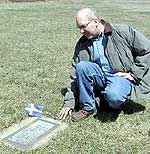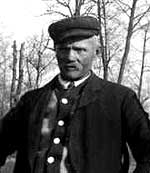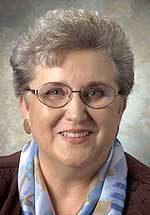By Dan Gunderson and Chris Julin
Minnesota Public Radio
July 29, 2002
| |
|
|
|
||
Randy Wall walks across a grassy field near the St. Louis County nursing home in Duluth. The barn from the old county poorfarm is visible through the trees.
"We should see the little cement numbers someplace here," he says, bending down to take get a closer look at the ground. "Boy, the grass has grown over a lot of them."
Randy Wall is looking for the marker he put on his great-great-uncle's grave five years ago. It takes him a few minutes to spot it.
"There's Uncle Paul," he says softly as he looks down on the granite plaque set into the grass.
The marker reads: "Paul Nickander. Born March 15, 1854. Died August 11, 1937. We live because we are remembered."
There are hundreds of graves in this field - marked with nothing but numbers. It looks like someone filled soup cans with cement and scratched a number into each one. They stuck one in the ground next to each grave. Randy Wall replaced his uncle's number with the granite marker.
| |
|
|
|
||
"I think a stone gives a final resting place some dignity. It also lets people know, 'I was here.' If we're not remembered, we didn't live then. I mean, who's going to know we lived? Who's going to know our story?"
Randy Wall only knows part of his great-great-uncle's story.
Paul Nickander was a bachelor lumberjack for decades. According to family lore, he went back to Sweden in the 1930s.
But Randy Wall learned the truth when wrote a family history a few years ago. He came across Paul Nickander's death certificate. It listed the place of death as the poorfarm in Duluth.
And that's all Randy Wall knows.
Lots of people have traced relatives to poorhouse cemeteries. Linda Crannell found her great-great-grandmother on a poorhouse roster in New York. Now she calls herself the Poorhouse Lady, and she runs a Website called the Poorhouse Story. She wants everyone to know the poorhouse story.
"These were people who were not held in regard in the community," she says. "Their lives were not valued. Their history wasn't respected. And there was simply no reason to feel their passing needed to be marked for history."
| |
|
|
|
||
That's what she wants to change.
"I think it's terribly important we realize that if we only know the history of the rich and famous in our community, we really don't know our history," she says.Mental illness and chemical dependency were common among poorhouse residents, but Linda Crannell says many people in turn of the century poorhouses had lived middle-class lives until illness or injury left them penniless. Whatever the circumstances that left a person poor, Crannell says the thinking used to be that poverty was caused by character flaws.
Cranell has seen many poorhouse rosters, and she says this is a typical list of reasons for admitting people to a poorhouse - intemperance, idiocy, idleness, vagrancy, debauchery, lunacy, blindness, old age, lameness, sickness, deaf and dumb, decrepitude.
She says the list also included "orphans, bastards, illegitimate children."
Next: Poor conditions at poorhouses



